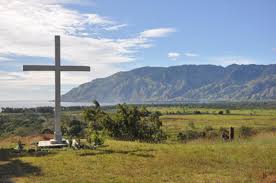2ND SEPTEMBER – THE NEW GUINEA AND AUSTRALIAN MARTYRS
.
During World War II in 1942 the Japanese quickly overran South East Asia and were advancing towards Australia. By July they had landed near Gona on the north-east coast of Papua. Here was an Anglican Mission station and hospital staffed by Fr. Benson, Sr. May Hayman and Miss Mavis Parkinson. With the approaching Japanese, they first fled to the forest but soon returned.
Some thirty miles away was another station at Sangara staffed by Fr. Vivian Redlich from England, a nursing sister, Margery Brenchley and a teacher, Lilla Lasmar. Not too far away at Isivita was another centre with Fr. Henry Holland and a layman, John Duffill.
When missionary priests, teachers and nurses were in danger of their lives with the Japanese invasion, Bishop Strong wrote urging them to stay at their posts:
We must endeavour to carry on our work. God expects this of us. The church at home, which sent us out, will surely expect it of us. The universal church expects it of us. The people whom we serve expect it of us. We could never hold up our faces again if, for our own safety, we all forsook Him and fled, when the shadows of the Passion began to gather around Him in His spiritual and mystical body, the Church in Papua.
Some four hundred Christians lost their lives, of which half were Catholics. Most of the Anglicans killed, were betrayed or killed by the natives. One Papuan, Lucian Tapiedi, tried to stop his fellow natives from committing murder, but he too was slain by a fellow native. He was a young teacher and evangelist who had been educated at mission schools where he had been influenced by Fr. Edwin Nuagoro, a Papuan. In 1939 Lucian had entered St. Aidan's Teacher Training College. Somehow, his bravery reached London, and alongside Bonhoeffer, Kolbe and seven others, is commemorated in niches of twentieth century martyrs on the great West Door of Westminster Abbey.
Another memento of this time also survives in London, a letter in St. Paul’s cathedral. Fr. Redlich, on the run in the bush, scribbled a letter to his father in England, titled, Somewhere in Papua and amazingly arrived at its destination. It is a letter to comfort his dad. “Don't worry about me, if anything happens to me, I will have had a good life and I will have done my best.” Sadly he was killed by the natives amongst whom he sought shelter.
As all Anglicans, except the above priest and Fr. Bernard Moore, were Australians, the New Guinea Martyrs, have become “blessed martyrs” of the Australian Anglican Church. After the war the Martyrs Memorial High School was built in their honour by the Anglican Church and most were decently interred. Their bravery in facing their deaths, especially a recent arrival, John Barge, who had to dig his own grave before being beheaded, has taught others much about being a faithful follower of Christ. We are surrounded by a great cloud of witnesses.
